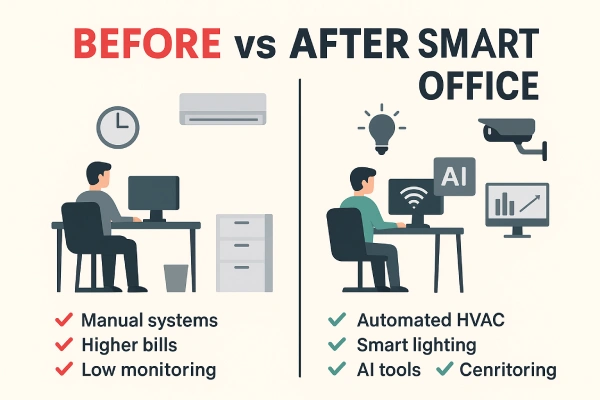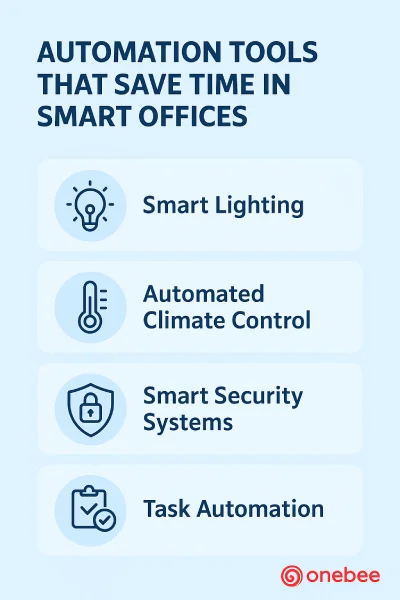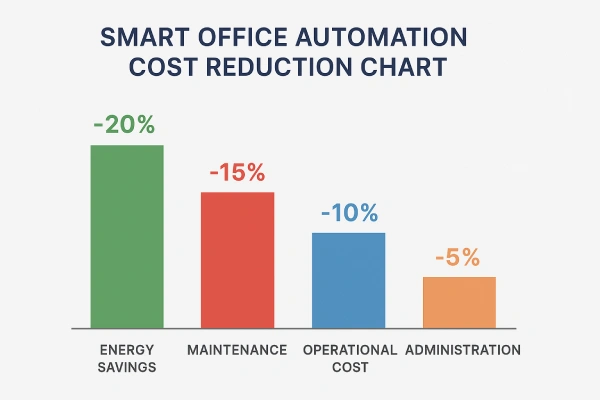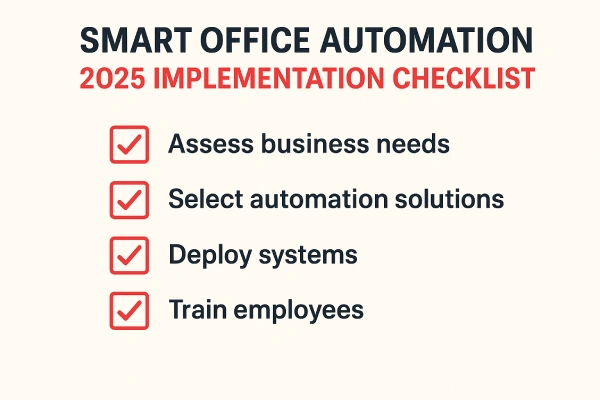The Future is Smart: Office Automation in 2025
- Introduction of Smart Offices: Change, Connect, Take Action
- Smart Office : How to Build, Implement and Develop
- Technology alternatives: Establish, Measure and Improve
- Install IoT Devices
- Observe using AI Systems
- Optimize using Cloud Management
- The managers are able to perform updates remotely and set accessibility, view security updates, and get dashboards. Cloud-based controls have the benefit of making resource allocation easier. This system repurposes unused or unbooked meeting space to the collaborative work set up (the workshops or presentations they install when needed).
- Justify the Automation of Productivity: Organize, Process, and Accelerate
- Minimize Spending: Audit, Cut and Avoid
- Inspire Employees: Customize, Instigate, and Develop.
- Recruit Employees: Personalise, Support, Improve
- Engage and Change: Train and Support, Transition
- Integrate Current Infrastructure: Interlink, Co-ordinate, improve.
- Upgrade Sustainability: Track, minimise, Report
- The Future Automation Trends: Plan, Promote and transform
- Smart offices find ways to advance the next stage: action, implementation, and management
- Frequently Asked Questions
- Summary: Welcome to Smart Office Automation
Introduction of Smart Offices: Change, Connect, Take Action
Smart office automation of 2025 is changing the face of workplaces where it can easily operate, connect and complete tasks using modern technologies. By sending team members, there are sensors that are activated; AI schedules meetings and manages maintenance. These technologies do not produce a noise making people focus on planning, creation and innovation.
Smart Office : How to Build, Implement and Develop

Traditional offices cannot be sustained by a static condition. As a result, digital controls are improved, sensors installed, and AI capabilities are implemented in companies. The devices dictate instructions to its surrounding that makes the lights shone, doors open, and attentions react in real-time. Team-workers are focusing on the long goals whereas these tools are used by office administrators in order to accomplish their daily assignments.
Technology alternatives: Establish, Measure and Improve

Install IoT Devices
Smart sensors that are implemented through IoT on offices detect, analyze, and respond. These technologies enhance the overall well-being and productivity by monitoring the movement of employees and the use of the workspace and by regulating temperature and lighting system timetables.
Observe using AI Systems
AI systems follow timeframes, predict the necessary maintenance and assess employee efficiency. They schedule conference rooms, handle automated chores, regulate entry of guests and follow through to evolve schedules. These systems minimise the compensation and streamline scheduling since they monitor the workflow.
Optimize using Cloud Management
The managers are able to perform updates remotely and set accessibility, view security updates, and get dashboards. Cloud-based controls have the benefit of making resource allocation easier. This system repurposes unused or unbooked meeting space to the collaborative work set up (the workshops or presentations they install when needed).
Justify the Automation of Productivity: Organize, Process, and Accelerate
Procedures and Workflows
Computerized programs reduce the time of approvals, coordinate logistics and processing of reservations. Office automation enables employees to spend their time on the strategy, high-impact discussions and ideation in a smarter environment through the removal of manual work that is often tedious.
Quick Meetings
The wireless meeting technology is used to assist with presentations, and will expedite setup as well as distribute timetables promptly. Teams have a higher work output due to assigning tasks, information exchange and following up.
Plan for Cooperation
Automation also promotes the smooth collaboration of the team by providing feedbacks, performing project deadlines, and communication within a group. Its employees are also informed, reminded, and access to shared documents.
Minimize Spending: Audit, Cut and Avoid

Calculate Your Energy Use
The lights in empty areas are dimmed or disabled by automation, the thermostats get adjusted, and the occupancy of rooms is inspected. Green causes are helped with teams, which use up to minimum energy and require less money on electricity.
Minimise Space Wastage
Space management allocates work-empty stations, tracks productivity patterns and suggests reconfiguring. Businesses can save money by maximizing on available square of space and reallocating the excessive expansions or rentals that are not essential.
Avoid Maintenance Problems
The sensors checking the temperature, humidity, and equipment state give a notification to the facility managers prior to the start of severe malfunctions. The automation keeps the things smoothly in order by fulfilling work-orders and to schedule visits.
Boost Security
Digital keys are granted and biometric doors are controlled via offices and use surveillance to keep track of reds and yellows. In case of ordeal, security automation rings bells, shuts the doors and fosters unauthorized access.
Inspire Employees: Customize, Instigate, and Develop.
Automation also allows flexible schedules, hybrid work arrangements and custom work station configuration. Employees can change lighting, temperature or workspace accessibility with their mobile devices. The systems promote job overload by providing comfort and health.
Recruit Employees: Personalise, Support, Improve
Automation will be used to customize the desk settings, allow flexible working schedules, and embrace hybrid work trends. Using mobile devices, employees can request change of workspace environment including the light, temperature, and access where needed. The systems further improve comfort and well-being and subsequently create increased employment satisfaction.
Engage and Change: Train and Support, Transition
The fast realisation of the benefits of the intelligent systems and associated workflows is achieved because of the training of staff provided by organizations. Change-management programs ease escalation of change, through communicating advantage and obtaining customer-feedback. Onboarding is also speeded up with the help of automation that familiarizes the new employees with the workplace tools, workflow, and corporate culture, thus increasing early productivity.
Integrate Current Infrastructure: Interlink, Co-ordinate, improve.
Intelligent office control is supported by an existing IT and software infrastructure or platform, such as CRM, HR, security and facility management software. The flow of data between components is synchronised by middleware and application programming interfaces (APIs), thereby avoiding data silos and maintaining a smooth operation. Integration points are tested constantly by the IT teams to ensure that the new automation works to integrate at the already established workflow.
Upgrade Sustainability: Track, minimise, Report
Smart offices minimize waste through controlling the systems that are not utilized, tracking the amount of water used, and controlling the effectiveness of HVAC. Automation can enhance the sustainability of buildings and reduce environmental impact by performing the scheduling of the repairs and sending the alert messages in case of mistakes.
The Future Automation Trends: Plan, Promote and transform
Automation would be more reactive towards offices, allow them to arrange their workspace in real-time, and track the faults in equipment. Next-generation AI customises the tasks people do daily; robots can help deliver documents and schedule meetings; remote connectivity is enhanced by virtual reality.
Smart offices find ways to advance the next stage: action, implementation, and management

Organizations embrace automation, use technology to create new innovation and set new standards in the workplace. Teams work more conveniently, managers can expand corporate plans, technology monitors functions by organizing, protecting, and supporting any jobs.
Frequently Asked Questions
1. How does smart office automation work?
Automation is used to tune-in IoT, AI, and cloud management at all levels, including scheduling, performance, adjusting, and protecting activities at the workplace.
2. Does automation stimulate nothing?
When smart systems take over reservations, meetings, resource, and optimization of workflows, teams will have increased areas to be innovative.
3. What are some of the cost reduction methods of smart workplaces?
The costly breakages are unwanted with predictive maintenance, space reallocation saves money, and the use of measurement tools regulates energy consumption.
4. What is the benefit of technology in security?
The systems handle requests to access, control doors, ring alarms and reduce threats before their consequences become serious.
5. Is it possible to automate personalized work experiences?
The workforce demands flexible work hours, adjustments to work stations and the automation of comfort with mobile settings.
6. What are the problems that companies should work on initially?
Managers must make periodic refresher of technology, assess the requirement of investing and also safeguard systems against problems.
7. What is the benefit of automation to the environment?
Systeems help them manage the environmental stewardship by cutting down wastewater, maximizing the use of water and power and triggering alerts to help in avoiding loss of resources.
8. Which transition trends will automation have?
Offices will predict workflow needs, create on-the-fly adjustments and streamline on-line conversations.
Summary: Welcome to Smart Office Automation
The automation of the smart office will allow companies to become more efficient, cut expenses, and keep their employees engaged in work by 2025. By using AI to automate repetitive processes and optimize resources and enhance security, the businesses entrust their workforce with the power to explore innovative solutions and develop the business and the wider industry. Embracing this technology today makes the workplace ready to be able to evolve quickly, able to adjust and survive in a rapidly changing world. The smart office is nowadays the modern reality of the successful business, not its future.